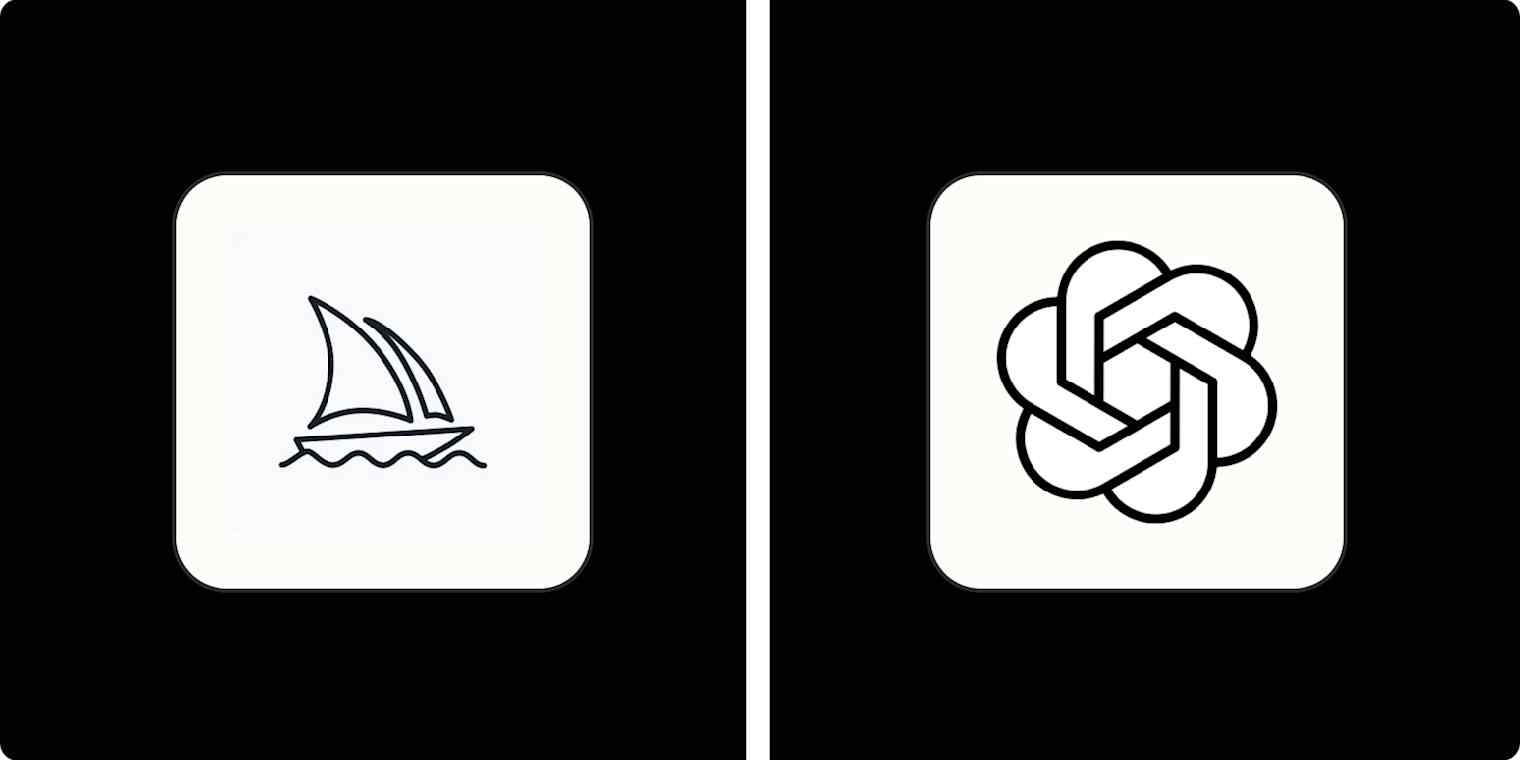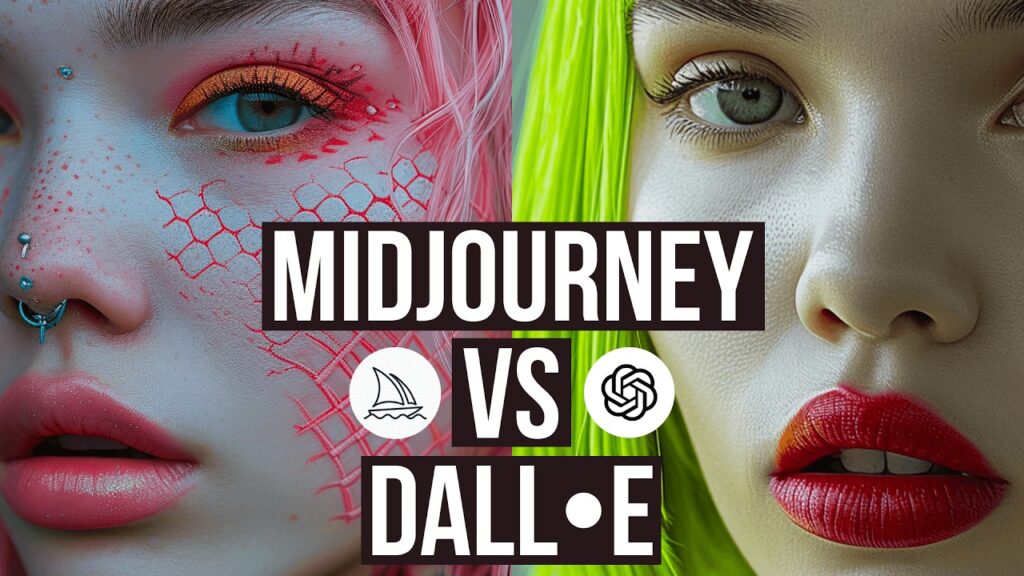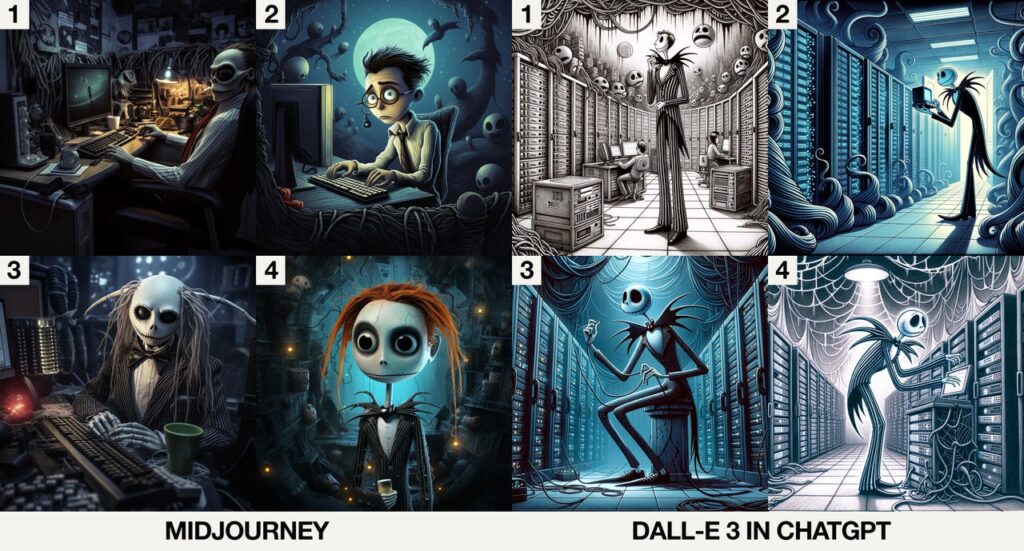The world of AI image generation is exploding, and if you’re curious about creating stunning visuals without being a professional artist, you’ve landed in the right place. Two titans dominate this exciting landscape: Midjourney and DALL-E 3. Both offer incredible capabilities, but they cater to different needs and styles. Understanding the nuances between Midjourney vs. DALL-E 3: Which AI Image Generator is Best? is key to unlocking your creative potential and choosing the tool that’s perfect for you. At AskByteWise.com, our mission is to make complex tech simple, and today, we’re diving deep to help you navigate this choice with confidence.
What Is AI Image Generation and Why Does It Matter?
Before we pit our champions against each other, let’s quickly demystify AI image generation. Think of it like this: You provide a description – a “prompt” – to a super-smart digital artist (the AI). This artist, powered by vast amounts of data and complex algorithms, then “imagines” and creates an image based on your words. It’s like magic, but it’s actually cutting-edge artificial intelligence at work.
This technology matters because it’s democratizing creativity. Whether you’re a small business owner needing unique marketing visuals, a student looking for concept art for a project, a blogger wanting eye-catching headers, or just someone looking to explore their artistic side, AI image generators offer unprecedented access to high-quality visuals. They save time, reduce costs, and open up entirely new avenues for expression.
Diving Deep: Understanding Midjourney
Midjourney burst onto the scene with a focus on stunning, often breathtaking, artistic output. It’s known for its ability to produce highly aesthetic, cinematic, and sometimes surreal images that feel incredibly polished right out of the box.
The Philosophy Behind Midjourney
Midjourney’s core philosophy seems to be about pushing artistic boundaries. It excels at generating images with a distinct visual style, often leaning towards painterly, illustrative, or photorealistic aesthetics that have a certain “wow” factor. It’s less about literal prompt interpretation and more about capturing the essence and mood you’re trying to convey.
Key Features and How It Works
Midjourney primarily operates through Discord, a chat application. This means you interact with the AI bot by typing commands into a chat window. While this might sound daunting to absolute beginners, it creates a unique, community-driven experience.
- Discord Interface: Users type
/imaginefollowed by their prompt into a designated server channel or direct message the bot. - Prompting Nuances: Midjourney responds exceptionally well to artistic directives, mood descriptors, and aspect ratio commands (e.g.,
--ar 16:9). It has a rich vocabulary of parameters that allow for fine-tuning, from--style rawfor less artistic intervention to--v 6to specify the latest, most advanced model version. - Iterative Process: Midjourney typically generates four initial image options. Users can then “upscale” one of these (make it higher resolution), or create “variations” of a chosen image to explore different interpretations of the original concept. This iterative refinement is a cornerstone of its workflow.
- Community and Collaboration: The public channels on Discord allow you to see what others are creating, learn from their prompts, and get inspiration. This fosters a vibrant community that is constantly experimenting and sharing.
Midjourney’s Strengths
- Unrivaled Aesthetic Quality: If your goal is visually stunning art, Midjourney often takes the crown. Its images frequently possess a cinematic quality, beautiful lighting, and intricate details that can be hard to achieve elsewhere.
- Artistic Versatility: From highly realistic portraits to abstract landscapes, sci-fi scenes, and fantasy art, Midjourney handles a vast array of artistic styles with finesse.
- Photorealism: Its latest versions, particularly
--v 6, are incredibly adept at generating images that are almost indistinguishable from actual photographs, especially for subjects like people and landscapes. - Creative Exploration: The iterative process encourages experimentation. You can start with a simple idea and evolve it in surprising directions, often discovering new creative paths you hadn’t initially considered.
Midjourney’s Weaknesses
- Learning Curve: The Discord-based interface and the need to learn specific commands and parameters can be a barrier for absolute beginners. It’s not as intuitively point-and-click as some other tools.
- Literal Prompt Interpretation: While excellent for artistic concepts, Midjourney can sometimes struggle with literal or precise prompt interpretation, especially when you need specific elements arranged in a particular way or accurate text within images.
- Consistency: Maintaining character or object consistency across multiple images can be challenging, although recent updates have improved this.
- Subscription Required: There is no free tier; you need a paid subscription to use Midjourney.
Ideal Use Cases for Midjourney
- Concept Artists & Illustrators: Generating initial ideas, mood boards, or detailed concept art for games, films, or books.
- Graphic Designers: Creating unique backgrounds, textures, or abstract elements for branding and marketing.
- Hobbyists & Digital Artists: Exploring new artistic styles, creating personal art pieces, or developing portfolio work.
- Photographers: Generating unique backdrops or composite elements.
Diving Deep: Understanding DALL-E 3
DALL-E 3, developed by OpenAI, approaches AI image generation from a different angle. It focuses heavily on understanding complex, nuanced prompts and integrating seamlessly into conversational AI platforms.
The Philosophy Behind DALL-E 3
DALL-E 3’s strength lies in its ability to take a detailed, descriptive prompt and translate it into a highly accurate and coherent image. It’s less about artistic interpretation (though it can be artistic!) and more about fulfilling the prompt’s instructions precisely. Its integration with ChatGPT is a testament to its goal of making AI image generation as natural as talking to a human assistant.
Key Features and How It Works
DALL-E 3 is primarily accessed through ChatGPT Plus (or higher tiers), or directly via the OpenAI API. This integration is a game-changer for prompt engineering.
- Natural Language Prompting: With DALL-E 3, you can write prompts in incredibly natural, conversational language. ChatGPT acts as an intermediary, often enhancing or refining your prompt behind the scenes to get the best results from DALL-E 3. You don’t need to learn specific commands or arcane parameters.
- ChatGPT Integration: This is its biggest selling point. You can have a dialogue with ChatGPT about the image you want. “Can you make an image of a cat playing piano?” “Sure. Can you make the cat wear a tiny top hat?” “Absolutely! And put a miniature audience of mice watching it.” This back-and-forth makes the creation process incredibly intuitive.
- Precise Prompt Interpretation: DALL-E 3 excels at understanding intricate details, specific object arrangements, and even text within images – a common weakness for many AI generators.
- Broad Style Range: While not always as “cinematic” as Midjourney by default, DALL-E 3 can still produce a wide variety of styles, from realistic to cartoonish, abstract to impressionistic, simply by describing them in the prompt.
DALL-E 3’s Strengths
- Exceptional Prompt Understanding: DALL-E 3 shines when it comes to translating complex, multi-layered prompts into accurate images. It rarely misinterprets your core intent.
- Text Generation: Unlike many AI image generators that struggle with coherent text, DALL-E 3 can generate legible and accurate text within images, which is incredibly useful for signs, logos, or even comic panels.
- Ease of Use: If you can type a sentence, you can use DALL-E 3. Its integration with ChatGPT makes it incredibly beginner-friendly, removing the barrier of learning specific commands.
- Subject Consistency: It handles maintaining consistent characters or objects across multiple images better than most, making it useful for short visual narratives.
- Accessibility: Being part of the ChatGPT ecosystem means it’s accessible to millions of users already familiar with that interface.
DALL-E 3’s Weaknesses
- Raw Artistic Flair: While it can produce beautiful images, its default output sometimes lacks the inherent artistic “pop” or cinematic quality that Midjourney often delivers, especially for highly stylized or photorealistic demands without very specific prompting.
- Less Direct Control: The conversational interface can sometimes feel less precise for advanced users who want granular control over every aspect of the image generation process, compared to Midjourney’s extensive parameters.
- No Free Tier (Directly): While you can try some limited DALL-E 3 features through Microsoft Copilot, full access requires a ChatGPT Plus subscription.
- Output Consistency: While good for characters, the overall “style” can vary more from prompt to prompt compared to Midjourney’s more consistent aesthetic.
Ideal Use Cases for DALL-E 3
- Content Creators & Marketers: Generating social media posts, blog headers, infographics, or simple illustrations with specific messages.
- Small Business Owners: Creating product mockups, simple logos, or advertising visuals with exact text requirements.
- Educators & Students: Visualizing complex concepts, creating diagrams, or illustrating presentations.
- Anyone Needing Specificity: When you need a highly specific image that exactly matches a detailed description, especially if it includes text.
Head-to-Head: Midjourney vs. DALL-E 3 Comparison
Now that we’ve looked at them individually, let’s put Midjourney vs. DALL-E 3: Which AI Image Generator is Best? head-to-head on key aspects.
Image Quality and Artistic Style
- Midjourney: Often produces images with a more inherently artistic, cinematic, and polished feel. It excels at photorealism, fantasy art, and anything that demands strong aesthetic appeal. Think of it as a master painter who brings their own flair to your request.
- DALL-E 3: While capable of diverse styles, its strength lies in accuracy and understanding. The images are high quality, but might not always have the same immediate “wow” factor for pure aesthetic art without very precise style descriptors. Think of it as a highly skilled technician who precisely executes your blueprint.
Verdict: For raw artistic beauty and “ready-to-use” visual impact, Midjourney often has an edge. For accurate representation of complex scenes or specific textual elements, DALL-E 3 is superior.
Prompt Interpretation and Control
- Midjourney: Responds well to creative language, artistic descriptors, and relies heavily on specific parameters (
--ar,--style,--v). Learning these parameters is key to unlocking its full potential. - DALL-E 3: Unmatched in natural language understanding. You can write long, descriptive paragraphs, and it will often integrate nearly every element. ChatGPT helps refine these prompts automatically.
Verdict: DALL-E 3 wins for ease of prompting and literal interpretation, especially for beginners. Midjourney offers more granular control for advanced users willing to learn its parameters.
Ease of Use and Accessibility
- Midjourney: Discord-based, requires learning commands. The initial setup and interaction can be a hurdle for non-tech-savvy users, but its community is very supportive.
- DALL-E 3: Web-based (via ChatGPT). It’s as simple as chatting with an AI. If you’ve used ChatGPT, you already know how to use DALL-E 3. This makes it incredibly accessible.
Verdict: DALL-E 3 is significantly easier for beginners to pick up and use instantly.
Specific Features and Capabilities
- Text Generation: DALL-E 3 is the clear winner here. It can generate coherent and accurate text within images consistently. Midjourney struggles significantly with text.
- Aspect Ratios: Both offer good control. Midjourney uses
--arparameters, DALL-E 3 can be specified in the prompt. - Inpainting/Outpainting: Both offer some capabilities. DALL-E 3’s inpainting (editing parts of an image) feels more integrated and intuitive through the ChatGPT interface. Midjourney has recent capabilities for ‘Vary (Region)’ and ‘Pan’ to extend images.
- Image Upscaling: Both offer upscaling. Midjourney’s upscaling often enhances the artistic details.
- Character Consistency: DALL-E 3 tends to be better at maintaining consistent characters across multiple images, vital for sequential storytelling or branding.
Verdict: DALL-E 3 wins for text generation and slightly better character consistency, while both offer robust image manipulation features.
Cost and Licensing
- Midjourney: Requires a paid subscription, starting from around $10/month. Different tiers offer more “fast GPU time” (faster image generation). Images generated can generally be used commercially, provided you have a paid subscription.
- DALL-E 3: Accessed primarily through ChatGPT Plus (around $20/month) or higher tiers, which includes access to GPT-4 and other advanced features. Images generated through DALL-E 3 can also be used commercially.
Verdict: DALL-E 3, through ChatGPT Plus, offers a broader suite of AI tools for a similar price point, making it potentially more cost-effective if you also use ChatGPT for writing. Midjourney is a dedicated image generation tool.
Practical Applications: Who Should Use Which?
The ultimate question is: which one is right for you?
-
Choose Midjourney if:
- You prioritize stunning artistic quality, cinematic aesthetics, and photorealism above all else.
- You are an artist, designer, or creative professional looking for unique inspiration or high-end visual assets.
- You enjoy the iterative process of refining images and are comfortable learning new commands and parameters.
- You want to be part of a vibrant, creative community on Discord.
- You don’t need accurate text within your images.
-
Choose DALL-E 3 if:
- You need highly specific images that accurately reflect a detailed prompt, especially with text included.
- You value ease of use, natural language interaction, and a shallow learning curve.
- You are a marketer, content creator, or small business owner needing versatile visuals for various platforms.
- You already use or plan to use ChatGPT for other tasks and appreciate the integrated experience.
- You need consistent characters or objects across a series of images.
The Future of AI Image Generation
Both Midjourney and DALL-E 3 are rapidly evolving. We’re seeing continuous improvements in image quality, prompt understanding, and new features like inpainting, outpainting, and consistent character generation. The future will likely bring:
- Even More Control: Advanced users will get more granular control, while beginners will find interfaces even more intuitive.
- Multi-Modal AI: The ability for AI to understand and generate not just images from text, but also video, 3D models, and even interactive experiences.
- Hyper-Personalization: Tailoring AI models to specific users or brand aesthetics.
- Ethical Frameworks: Stricter guidelines and tools for detecting and preventing misuse, ensuring responsible AI development.
The landscape is dynamic, and continuous learning will be key to staying ahead.
The Verdict: Which AI Image Generator is Best for You?
There’s no single “best” AI image generator; it truly depends on your specific needs, skill level, and creative goals.
-
For the aspiring digital artist, the creative professional, or anyone seeking breathtaking visual artistry, Midjourney is your go-to. Its mastery of aesthetics and continuous innovation in artistic quality are hard to beat. Embrace the Discord interface, learn its parameters, and prepare to be amazed.
-
For the content creator, the small business owner, the educator, or anyone who values precision, ease of use, and versatility for practical applications (especially with text), DALL-E 3 is your champion. Its ability to accurately translate complex prompts and seamlessly integrate with ChatGPT makes it an incredibly powerful and accessible tool.
Many professionals even use both – Midjourney for the primary aesthetic “hero” images, and DALL-E 3 for specific graphic elements, social media snippets with text, or quick mockups. Don’t be afraid to experiment with trials or short-term subscriptions if available to see which workflow resonates most with you.
Conclusion
Choosing between Midjourney vs. DALL-E 3: Which AI Image Generator is Best? is an exciting decision that opens up a world of creative possibilities. Both are phenomenal tools that exemplify “Making Complex Tech Simple” by empowering users to create incredible visuals. Whether you’re drawn to Midjourney’s artistic prowess or DALL-E 3’s precision and user-friendliness, you’re stepping into the future of digital creation. Dive in, experiment, and let your imagination soar!
Frequently Asked Questions (FAQ)
Q1: Can I use images generated by Midjourney or DALL-E 3 for commercial purposes?
Yes, generally, if you have a paid subscription to either service, you are granted commercial use rights for the images you generate. Always double-check the latest terms of service for each platform as they can evolve.
Q2: Do I need to be good at “prompt engineering” to use these tools?
While both tools benefit from well-crafted prompts, DALL-E 3, especially through ChatGPT, is very forgiving for beginners and can help you refine your prompts. Midjourney has a steeper learning curve for advanced prompting, but its default outputs are often impressive even with simple prompts. Think of prompt engineering as learning to communicate clearly with a very sophisticated artist – the clearer your instructions, the better the result.
Q3: Are there any free alternatives to Midjourney and DALL-E 3?
Yes, there are several free options available, though they might not offer the same level of quality or specific features. Examples include some features in Microsoft Copilot (which uses DALL-E 3), Stable Diffusion (which can be run locally or via online interfaces like DreamStudio), and various web-based tools that offer limited free generations.
Q4: Which one is better for generating human faces or realistic portraits?
Both have made significant strides in generating realistic human faces. Midjourney, particularly with its latest models (--v 6), often excels at producing highly photorealistic and aesthetically pleasing portraits. DALL-E 3 can also do this very well, especially if your prompt describes the subject and style meticulously. It often comes down to the specific aesthetic you’re aiming for.
Q5: How do they handle ethical concerns like bias or harmful content?
Both OpenAI (DALL-E 3) and Midjourney have implemented safeguards to prevent the generation of harmful, illegal, or biased content. This includes content filters, moderation, and strict usage policies. They continuously work to improve these systems to ensure responsible AI development and prevent misuse.
See more: Midjourney vs. DALL-E 3: Which AI Image Generator is Best?.
Discover: AskByteWise.



